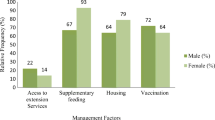Abstract
Participatory rural appraisal (PRA), supported by checklists and intensive case studies on individual households, was carried out in three villages at three different altitudes in the central highlands of Ethiopia. The chicken production system in each village is described and the problems are discussed. More than 60% of the families kept chickens, and in most cases the women owned and managed the birds and controlled the cash from the sales. The production systems followed were mainly low-input and small-scale, with 7–10 mature birds per household, reared in the back yards with inadequate housing, feeding and health care. The average egg production per clutch was 15–20, with 3–4 clutches per year. The mean number of eggs set per bird was 12.9±2.2 (n = 160), depending on the size of the bird and season, and the hatching rate was 80.9%±11.1%, range 44%–100% (n = 160). Poultry meat and eggs were generally accepted and appreciated in all three villages. In addition to the small amount of cash income they provide, scavenging chickens have nutritional, cultural and social functions. The flock composition, price of poultry and poultry products, disease outbreaks and hatching of chicks were strongly affected by season. Disease was cited as the most important problem by most of the members of the community, followed by predation, lack of feed, poor housing, insufficient water and parasites. Disease periodically decimated the flocks, and consequently, about 50% of the eggs produced were incubated in order to replace the birds that had died. The major source of loss in the system was the high mortality of chicks (61%) that occurred between hatching and the end of brooding at 8 weeks of age. The system was characterized by no or few inputs and a low output level. The major input was the cost of foundation stock, but after that virtually no cost was involved. The major source of feed for the birds was from the scavenging feed resource base, which comprised table leftovers, small grain supplements and anything edible from the immediate environment.
Similar content being viewed by others
REFERENCES
AACMC, 1984. Livestock Sub-sector Review, vol. 1, Annex 3 (Australian Agricultural Consulting and Management Company)
Alemu, Y., 1995. Poultry production in Ethiopia. World's Poultry Science Journal, 51, 197-201
ANRPD, 1994. Training Manual for Baseline Data Collection on Rural Poultry Production ((E.B. Sonaiya, ed.), (Poultry Research Group, Department of Animal Science, Obafemi Awolowo University, Ile-Ife, Nigeria)
Cummings, R.B., 1992. Village chickens production: problems and potential. In: P.B. Spradbrow (ed.), Proceedings of an International Workshop on Newcastle Disease in Village Chickens, Control with Thermostable Oral Vaccines, Kuala Lumpur, 21-24
Feltwell, R. and Fox, S., 1978. Practical Poultry Feeding, (Faber and Faber, London)
Guèye, E.F., 1998. Village egg and fowl meat production in Africa. World's Poultry Science Journal, 54, 73-86
ILCA, 1983. Research on farm and livestock productivity in the central Ethiopian highlands: initial results, 1977–1980, (ILCA Research Report no. 4; ILCA, Addis Ababa)
Nasser, M., Lohr, J., Mebratu, Y., Zessin, K.-H. and Ademe, Z., 1998. Oral feed-based Newcastle disease vaccination trials in Ethiopia with the Australian V4 vaccine strain. Scientific Proceedings of the Fourth Asia Pacific Poultry Health Conference, Melbourne, 129
Roberts, J.A., 1992. The scavenging feed resource base in assessments of the productivity of scavenging village chickens. In: P.B. Spradbrow (ed.), Proceedings of an International Workshop on Newcastle Disease in Village Chickens, Control with Thermostable Oral Vaccines, Kuala Lumpur, 29-32
Röling, N, 1988. Extension Science: Information Systems in Agricultural Development, 2nd edn, (Cambridge University Press, Cambridge)
Savory, C. J., 1989. The importance of invertebrate food to chicks of gallinaceous species. Proceedings of the Nutrition Society, 48, 113-133
Smith, A.J., 1990. Poultry (Tropical Agriculturist series, CTA; Macmillan, London), 67-68
Sonaiya, E.B., 1990. The context and prospects for development of smallholder rural poultry production in Africa. CTA-Seminar Proceedings on Smallholder Rural Poultry Production, Thessaloniki, 1, 35-52
Sonaiya, E.B., Branckaert, R.D.S. and Guèye, E.F., 1999. Research and development options for family poultry. First INFPD/FAO Electronic Conference on Family Poultry, 〈http://www.fao.org/waicent/faoinfo/agricult/age/agap/lps/fampo/fampo.htm〉
Tadelle Dessie, 1996. Studies on village poultry production systems in the central highlands of Ethiopia, (MSc thesis, Swedish University of Agricultural Sciences)
Teketel, F., 1986. Studies on the meat production potential of some local strains of chickens in Ethiopia, (PhD thesis, J.L. University of Giessen)
Van Veluw, K., 1987. Traditional Poultry Keeping in Northern Ghana, (Centre for Information on Low-External-Input and Sustainable Agriculture (ILEIA), 3, 12-13
Author information
Authors and Affiliations
Rights and permissions
About this article
Cite this article
Dessie, T., Ogle, B. Village Poultry Production Systems in the Central Highlands of Ethiopia. Tropical Animal Health and Production 33, 521–537 (2001). https://doi.org/10.1023/A:1012740832558
Issue Date:
DOI: https://doi.org/10.1023/A:1012740832558




